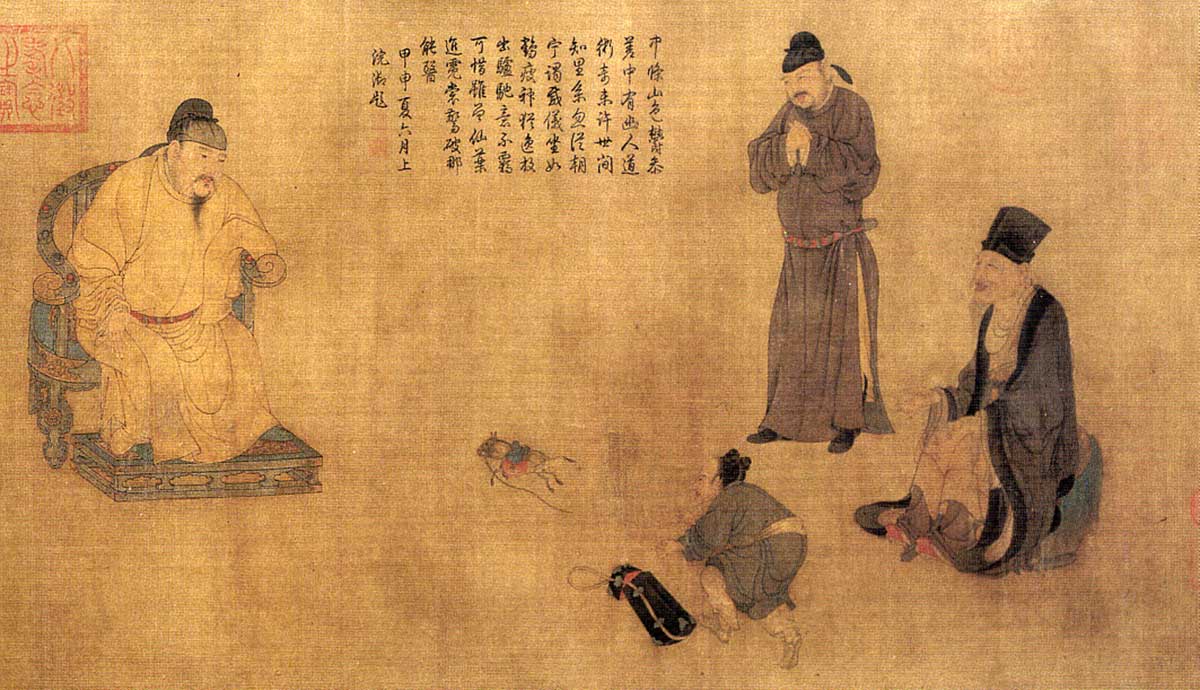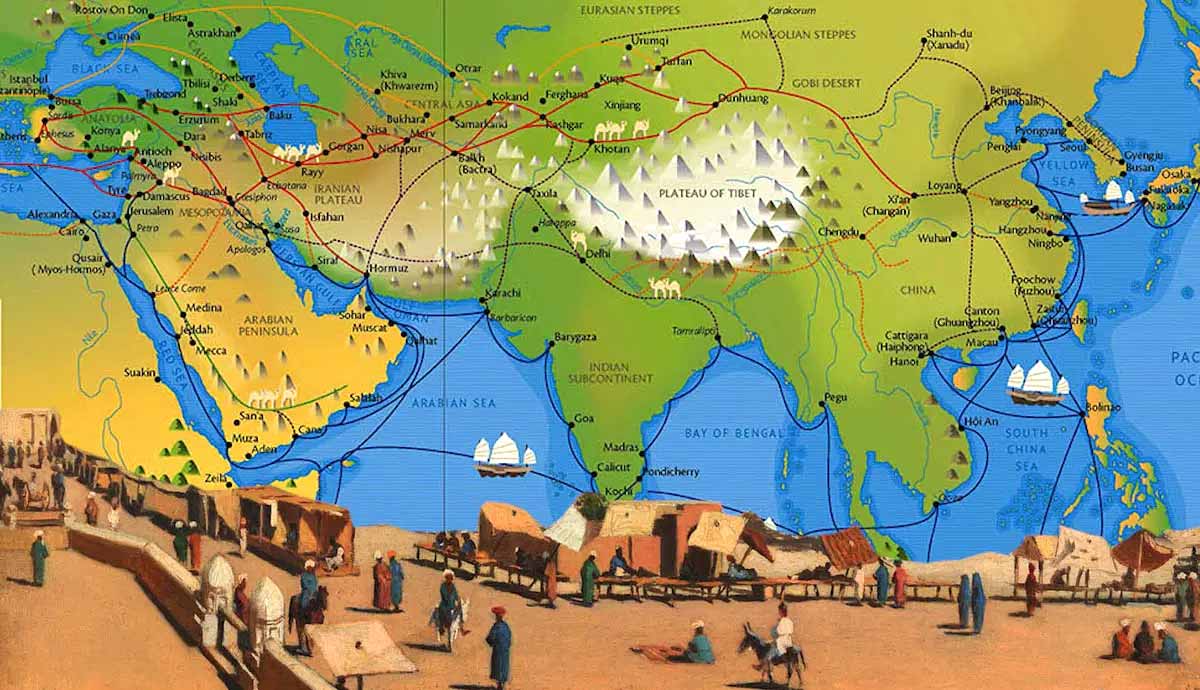
Zhang Xuan (713-755) lived and worked as a court painter in Chang’an (known today as Xian), the contemporary capital of Imperial China. After a period of conflict and instability, the Sui dynasty (589-618) had successfully unified the region. When the Li family took power and began the Tang dynasty, they utilized much of the infrastructure initiated under the Sui, including the system of taxation and the system of standardized examinations for court officials. The Tang dynasty (618-907 CE) was the zenith of unity and prosperity in the imperial era.
The most prosperous era of the Tang dynasty was the Kaiyuan era (712-741 CE) in the reign of Emperor Xuanzong (685-762), also known as minghuang (“the brilliant monarch”). His reign was militarily stable, he reformed the taxation system to bring more revenue to the imperial treasury, and he was a committed patron of the arts.
Sincere or Satire? Zhang Xuan’s Lady Guoguo’s Spring Outing

Zhang Xuan was best known for his handscroll paintings of the everyday activities of courtly women. This genre is known as meirenhua, but is also simply dubbed the “paintings of beautiful women”. Indeed, it is the fine, detailed clothing and poised, made-up expressions of the women that most capture a viewers’ attentions, far more than the dynamism of their behavior. Nonetheless, Zhang’s paintings are not purely voyeuristic decorations; they contain commentary and have inspired critique.
The painting above depicts Lady Guoguo and her attendants riding out for a trip in Spring. This outing, which occurred on the third day of the third lunar month, was a tradition under the Tang dynasty, particularly for aristocratic women. Lady Guoguo was an older sister of Yang Yuhan — more commonly known as Yang Guifei — who was Emperor Xuanzong’s favorite consort. Yang Guifei became a highly controversial figure in the Tang court, in part for lavishing patronage on her family members and distracting Emperor Xuanzong from his duties. Her controversial presence was deemed the reason behind the An Lushan rebellion in (755-763), which led to the decline of the Tang dynasty and to hers own death.
It was typical of the Tang dynasty figure painting style to have detailed, sculptural figures set against a blank background, as demonstrated in this image. However, this begs the question: How do we know it is set in Spring? With no environmental indicators of the seasons changing, it seems difficult to determine. Part of Zhang’s virtuosity is that the environment is communicated by the figures themselves. Shui Tian argues that the evident affluence and contentment of the figures in the work, combined with the “bouncy trot of the horses” conveys the setting as a balmy spring day. Indeed, the light fabric and open necklines of many of the women suggests a relatively warm climate.

Additionally, the seals and inscriptions around the image provide further context. Although it would be impermissible in a western context to tamper with the fabric of a famous artwork, in a Chinese context, people often added seals, and the inscriptions of subsequent owners and connoisseurs contributed value to an artwork. Some inscriptions associate this painting with the Tang poet Du Fu’s Trip of Beauties, a satire on the extravagant outings of Yang Guifei’s sisters. Du Fu begins by describing the ladies’ attire on their outing, then segues into descriptions of their wealth more broadly, gradually growing more critical.
The most striking stanza discusses the extravagant meals plated up for Yang Guifei’s relatives, including “purple camel meat”, and “rows of translucent plates full of fresh white fish.” However, Yang’s family become bored of these lavish feasts and are served food although they are not hungry, despite the existence of hungry workers outside the palace. Due to the presence of this contemporary poem on the handscroll, it is unclear whether Zhang intended for this work to be a neutral representation of Lady Guoguo and her entourage, or whether their evident sartorial opulence is intended to fuel court critiques of Yang Guifei and her family.
Monotony or Meditation? Court Ladies Preparing Newly Woven Silk

Court Ladies Preparing Newly Woven Silk depicts several women of different ages working together across the various jobs required to prepare silk for making clothing. Read from right to left, they are divided into three groups of different activities: pounding, sewing, and ironing. This work is not intended to be instructive, but rather it is intended to demonstrate the mundane tedium of women’s daily lives.
This work’s mood is enigmatic: some viewers might see it as a picture of tedium, whereas others might view it as pleasantly contemplative. The former opinion is evident in the fact that though the women are pictured working communally, they are clearly isolated from one another. The Tang style of having statuesque figures positioned individually against a blank background is the first indicator of this isolation. Though almost all figures are linked literally as well as figuratively by their work (all the women engaged in ironing are linked by touching the silk cloth, for example) none of the figures look at one another, and none of them have their mouths open as if they are speaking. Rather, each of them has their head bowed towards their work in quiet isolation.

However, one might argue that it is difficult to make out the women’s facial expressions in any detail and argue that they are, in fact, looking at one another. They may not be chatting, but they are nonetheless enjoying one another’s company and rhythmically completing household tasks as a community. The ossified body language of the pounders and ironers is disrupted by the young girl standing beneath the silk being ironed, who looks up inquisitively at the fabric’s underside. While some viewers might argue that her curiosity contrasts sharply with the disinterest evident in the body language of every other figure, it is also possible to see her dynamic body language reflected in that of the sewers. The sewer on the right opens her arms wide; whether she is cutting a length of thread or gesticulating while she speaks is unclear.
This work is a fine example of the sculptural quality of Zhang Xuan’s figures and compositions. Each figure here is very firmly delineated by her outline, and while the modeling of each figure’s clothing is not particularly shaped to their body beneath, Zhang’s use of clear lines to demarcate the fold of each lady’s dress lends these figures a sculptural quality. Moreover, they are all caught in arrested motion, but none of their actions are particularly dynamic. In part, this is communicated by the dense, straight lines Zhang uses.
Antecedents & Inspiration: Gu Kaizhi & Yan Liben

Figure painting in China has a long history, and by the Tang dynasty some of the superstars of that history had already been and gone. The Tang dynasty inherited two schools of style: the carefully-controlled lines of artists like Gu Kaizhi and Yan Liben, versus the expressive brushwork of Zhang Sengyao and Wu Daozi. It is generally argued that Zhang follows the tradition of Gu and Yan by using conservative, definite brushwork.
Certainly, Zhang’s brushwork generally delineates the outline of his figures’ forms carefully and completely. His inkwork rarely fades or tapers, which might indicate a swiftly-made brushstroke, and suggest his figures are moving swiftly or dynamically. Nonetheless, Zhang’s brushwork is not stiff or restrictive. The sinuous lines Gu Kaizhi uses to articulate his figures’ drapery is highly dramatic, as though all his figures’ clothing have been inflated by a strong wind. Zhang takes inspiration from Gu’s fluid forms, but his rendering of robes is more subtle and naturalistic.
The curves and folds of drapery in Court Ladies Preparing Newly Woven Silk realistically describe the way light fabric falls around a body. Further, Zhang depicts the fabric bunching realistically at the feet of these women, which gives the viewer a sense of the dimensions of the (otherwise omitted) environment these women are working in.

While also being clearly delineated, Yan Liben created textural variations in his work, which is certainly a technique Zhang Xuan emulated. In Xiao Yi Trying to Swipe the Lanting Scroll, Yan uses many thin, curved lines placed close together to render the texture of hair in the beards of the figures on the far left and right. This stands in marked contrast to the thicker, more consistent width of the lines Yan uses to delineate each figure’s drapery and their outlines. Zhang Xuan employs a similar technique for the manes and tails of horses in Lady Guoguo’s Spring Outing, as these are the only items within the composition that are not firmly delineated. Rather, they have a “hazy” effect towards the edges of the mane and tail, which is achieved by the artist using many very thin ink lines, tightly packed together in the middle, then incrementally further apart from one another towards the edge.
The Issue of Copying

Analyzing ancient Chinese artworks with the typical methodology of western Art History, is fundamentally flawed, given the prevalence and importance of copying in Chinese painting. Copying artworks was one of the, if not the most, important way that young artists developed their skills. It is an age-honored and necessary tradition, of which there are four types: mu (to trace), lin (to copy), fang (to imitate), tsao (to invent).
Copying was necessary before an age of mechanical reproduction, in which courtiers and Emperors commissioned copies for particularly prized ancient artworks, such that they might be distributed more widely and preserved. Further, Wen C. Fong argues that in terms of the development of artistic style, ancient models were seen as a “non-historical continuum,” thus an artist’s originality was only appreciated when it was “presented in the guise of tradition.”
None of the artworks discussed in this article are likely to be the “original” — i.e. they are unlikely to have been made by the artist they are attributed to. However, Fong argues, using Gu Kaizhi’s Admonitions scroll as an example, that when we say that the artwork we are looking at is a copy, “we mean that, in spite of certain more advanced qualities which we consider to be as late tenth- or early eleventh-century, the drawing and design as a whole have preserved much of the original style of the fourth century”.
The presence of prevalent copying does not prevent art historians from analyzing artworks: regardless of whose hand (or hands, in the case of a workshop item) crafted the work, they used certain techniques that produce specific effects. However, issues can arise when attributing these stylistic features, as without the original handscrolls (or a sophisticated overview of stylistic change) it is difficult to ascertain whether details of the technique are copied from the original composition, or are an innovation of the copying artist.
Zhang Xuan in Summary

Zhang Xuan is undoubtedly one of the most treasured artists of ancient Chinese art. He brought women to the front and center of his work and paid close attention to their attire, their behavior, and their psychological interests. While Zhang prospered in the Tang dynasty, his work has prospered long after him. Copies of his work — such as this reproduction of the Spring Outing of Lady Guoguo by Pu Ru — are still being made. This is a resounding testament to the importance of copying in Chinese art, and to Zhang’s continued influence.








